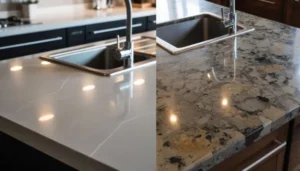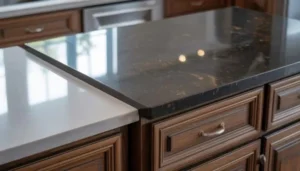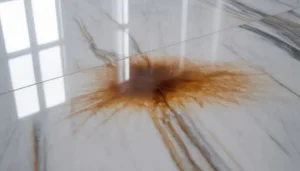Unlocking the Beauty of Travertine Tile: Polishing Techniques and Tips
Travertine tile is a luxurious and versatile building material that has been cherished for centuries. It is a type of natural stone formed from calcium carbonate deposits, often found near mineral-rich hot springs. What makes travertine particularly appealing is its unique combination of durability, timeless beauty, and a range of stunning earthy hues. This exquisite stone has been used throughout history to create breathtaking architectural marvels, from ancient Roman structures to modern-day homes.
Table of Contents
ToggleWith the timeless beauty of travertine tile and other natural stone surfaces, we at SF Marble And Granite Inc. are committed to assisting you in realizing your design objectives and creating beautiful places. For a free consultation, get in contact with us right now, and let’s get started on your next project

The hallmark of travertine is its distinctive appearance, characterized by intricate patterns and rich colors. Its surface may feature charming imperfections, such as small holes and irregular veining, which add to its character and appeal. Each travertine tile is a work of nature, making it a sought-after choice for homeowners and designers seeking to add a touch of sophistication to their spaces.
One of the key attractions of travertine is its versatility. It can be employed in various applications, including flooring, wall cladding, travertine countertops, and even decorative accents. Whether you are looking to create a rustic ambiance with tumbled travertine or a polished, contemporary look with honed travertine, this stone adapts beautifully to diverse design styles.
Furthermore, travertine tile is celebrated for its ability to withstand the test of time. When properly maintained, it can maintain its luster and charm for generations. Its inherent durability makes it an excellent choice for high-traffic areas in both residential and commercial settings.
Understanding the Importance of Polishing
How to Polish Travertine Tile is a crucial aspect of its care and maintenance, and it plays a significant role in preserving the natural beauty and longevity of this exquisite stone. Let’s delve into why polishing is so important:
Enhancing Aesthetic Appeal:
Polishing travertine tile enhances its aesthetic appeal significantly. This natural stone is known for its unique patterns, rich colors, and charming imperfections. However, over time, these features can become dull and less pronounced due to wear, dust, and stains. Polishing rejuvenates the surface, bringing out the stone’s inherent beauty, vibrant colors, and captivating patterns. It’s like giving your travertine a new lease on life, restoring it to its original splendor.
Adding a Protective Layer:
Polishing not only enhances the appearance but also adds a protective layer to the travertine tile. This protective layer acts as a shield against stains, spills, and everyday wear and tear. It forms a barrier that prevents liquids and contaminants from penetrating the porous surface of the stone, making it easier to clean and maintain. Without regular polishing, travertine can become susceptible to damage and staining, diminishing its overall quality.
Preventing Stains and Damage:
Travertine is a porous stone, meaning it has tiny openings on its surface that can trap liquids and particles. If not properly sealed and polished, these pores can become breeding grounds for stains, especially in areas with heavy foot traffic or exposure to moisture. Polishing helps seal these pores, making it more challenging for stains to penetrate the surface. Additionally, it protects against surface scratches and minor damages, preserving the integrity of the tile.
Prolonging Lifespan:
Regular polishing is a key factor in prolonging the lifespan of travertine tile. By maintaining the stone’s surface and preventing damage, you ensure that your investment in this beautiful natural stone lasts for years to come. Properly polished travertine not only retains its appeal but also remains functional and durable, making it a wise choice for various applications within your home or commercial space.
Materials and Tools You'll Need for Polishing Travertine Tile
Before you embark on the journey of how to Polish Travertine Tile to restore its natural beauty, it’s essential to gather the necessary materials and tools. Here is a complete list of everything you will demand:
- Travertine Polishing Pads: These specialized pads are designed for polishing natural stone surfaces like travertine. They come in various grit levels, allowing you to achieve different levels of shine and smoothness.
- Polishing Machine (Optional): For larger areas or more extensive projects, a polishing machine, also known as a floor buffer or polisher, can be highly efficient. It helps you cover more ground quickly and evenly.
- Diamond Hand Pads: For smaller or intricate areas that the polishing machine can’t reach, diamond hand pads are essential. They provide precise control and are perfect for edges, corners, and tight spaces.
- Stone Sealer: After polishing, it’s crucial to apply a quality stone sealer. This sealer acts as a protective layer, helping to prevent stains and moisture from penetrating the travertine’s porous surface.
- Clean, Soft Cloths: You’ll need clean, lint-free cloths or microfiber towels for wiping down the surface during and after the polishing process. These ensure a streak-free finish.
- Mild Stone Cleaner: Before polishing, it’s essential to clean the travertine tile thoroughly. A mild stone cleaner is safe for natural stone surfaces and effectively removes dirt, grime, and any residues.
- Safety Gear: Don’t forget safety gear, including gloves and goggles, to protect your hands and eyes from potential splashes of water, polishing compounds, or dust during the process.
Gathering these materials and tools ensures that you have everything you need to achieve a successful travertine tile polishing project. Whether you’re working on a small area or a larger space, having the right equipment and products at your disposal will make the process more efficient and effective, resulting in a beautifully polished travertine surface that you can enjoy for years to come.
Preparation Steps for Polishing Travertine Tile
Before you begin the actual process of polishing your travertine tile, it’s essential to prepare the surface adequately. This involves two critical steps: cleaning the surface and repairing any damages.
Cleaning the Surface:
- Gather Your Cleaning Supplies: To start, gather your mild stone cleaner, clean, soft cloths, and a bucket of warm water.
- Dust and Sweep: Begin by removing loose dirt and debris from the travertine tile surface. Use a broom or a dust mop to sweep away any dust, crumbs, or loose particles. This step helps prevent these particles from scratching the surface during the polishing process.
- Prepare a Cleaning Solution: In a bucket, mix your mild stone cleaner with warm water according to the manufacturer’s instructions. Make sure the solution is well-diluted.
- Clean the Surface: Dip a clean, soft cloth into the cleaning solution, wring it out so it’s damp but not soaking, and gently wipe down the entire surface of the travertine tile. Pay close attention to any spots that have stains or filth that can be seen. Allow the cleaner to sit for a few minutes to loosen any stubborn residue.
- Scrub as Needed: For tough stains or grout lines, you can use a soft-bristle brush to gently scrub the affected areas. Be cautious not to apply excessive pressure to avoid scratching the surface.
- Rinse Thoroughly: After cleaning, use a separate clean cloth dampened with clean water to thoroughly rinse the surface. This procedure eliminates any leftover cleaning agent.
- Dry Completely: Ensure that the travertine tile surface is completely dry before proceeding to the next steps. This usually takes about 30 minutes to an hour, depending on the humidity levels in your location.
Repairing Any Damages:
- Inspect the Tile: Examine the travertine tile closely for any visible damages such as cracks, chips, or deep scratches. These imperfections can affect the quality of the polished finish.
- Acquire a Travertine Repair Kit: If you find any damages, you can typically repair them using a travertine repair kit, which is readily available at home improvement stores. Ensure that the kit you choose matches the color and finish of your travertine tile.
- Follow Kit Instructions: Follow the instructions provided with the repair kit carefully. Typically, you’ll mix the repair compound according to the instructions, fill in the damaged areas, and allow it to cure for the recommended time.
- Sand and Smooth: After curing, gently sand the repaired areas with fine-grit sandpaper until they are level with the surrounding tile.This guarantees a smooth, even surface.
The Polishing Process
When it comes to restoring the natural luster of your travertine tile, the polishing process is the key to achieving that desired shine. This process involves several crucial steps:
Wet vs. Dry Polishing:
Before you begin polishing, you have the option to choose between wet and dry polishing methods. Each method has its advantages, and your choice may depend on your preferences and project requirements:
Wet Polishing:
- Less Dust: Wet polishing involves the use of water, which significantly reduces dust production during the process. This is a cleaner option, making it more suitable for indoor projects or areas where dust control is crucial.
- Cooler Surface: The water used in wet polishing helps to keep the surface cool, preventing the risk of overheating the travertine tile, especially during extended polishing sessions.
- Easier Clean-Up: Since the dust is minimal, cleaning up after wet polishing is relatively straightforward. You’ll primarily need to deal with water residue.
- Slower Process: Wet polishing can take longer than dry polishing, as you may need to work in smaller sections to manage the water.
Dry Polishing:
- Faster Process: Dry polishing is generally faster than wet polishing, making it a more time-efficient option. This is especially useful for larger areas or when you need to complete the project quickly.
- Less Equipment: Dry polishing typically requires fewer tools and equipment, as you don’t need a constant water source.
- Dust Management: Dry polishing generates more dust, so it’s essential to have effective dust management systems in place, such as vacuum attachments on your polishing machine or dust containment measures.
- Heat Concerns: Dry polishing can generate heat on the surface, so it’s crucial to monitor the temperature and avoid overheating, which can potentially damage the travertine tile.
Choosing the Right Polishing Pads:
The choice of polishing pads is another critical consideration for achieving the desired results when polishing travertine tile:
- Grit Levels: Polishing pads come in various grit levels, ranging from coarse to fine. The selection of pads depends on the condition of your travertine tile. Coarser grits are suitable for rough or damaged surfaces, while finer grits are used for achieving a high gloss finish on smoother tiles.
- Pad Types: There are different types of polishing pads, including diamond pads and resin pads. Diamond pads are more abrasive and are used for initial grinding and leveling. Resin pads are finer and are typically used for the final polishing stages to achieve a glossy finish.
- Pad Size: Choose the pad size that fits your polishing machine or hand pad holder. Ensure that the pad size is appropriate for the size of the area you are working on.
- Pad Quality: Invest in high-quality polishing pads to ensure consistent results and durability. Lower-quality pads may wear out quickly or provide inconsistent performance.
By carefully considering whether to use wet or dry polishing and selecting the right polishing pads, you can tailor your approach to match the specific needs of your travertine tile project. These decisions play a significant role in achieving the desired level of shine and surface quality during the polishing process.

Step-by-Step Polishing Instructions
Now that you’ve prepared your travertine tile surface by cleaning it and addressing any damages, it’s time to proceed with the polishing process. Follow these step-by-step instructions to achieve a beautiful, glossy finish:
Attach the Polishing Pad:
- If you’re using a polishing machine, start by attaching the appropriate polishing pad to the machine’s pad holder. Ensure it’s securely fastened.
Select the Starting Grit:
- Choose the polishing pad with the appropriate grit level for your travertine tile’s condition. If your tile has deeper scratches or rough areas, start with a coarser grit pad and gradually move to finer grits.
Apply Water (For Wet Polishing):
- If you’ve opted for wet polishing, lightly dampen the travertine tile surface with water. Ensure it’s evenly moist but not excessively wet.
Start the Polishing Machine:
- If using a polishing machine, turn it on at a low speed to avoid splattering polishing compound. Always operate the machine as directed by the manufacturer.
Begin Polishing:
- Hold the polishing machine or pad holder firmly and start polishing the travertine tile surface. If you’re working on a small area, you can use diamond hand pads instead, applying gentle pressure.
Use Circular Motions:
- Move the machine or pad holder in small, overlapping circular motions across the tile surface. Ensure even coverage and avoid concentrating on one spot for too long, as this can cause uneven polishing.
Progress to Finer Grits:
- After completing the initial pass with the starting grit pad, switch to a finer grit pad. Repeat the circular polishing motion. Gradually progress to even finer pads until you achieve the desired level of shine. Remember to clean the surface between pad changes.
Monitor Surface Temperature:
- Keep an eye on the temperature of the travertine tile surface, especially during dry polishing. If it becomes too hot, pause and allow it to cool down to prevent any potential damage.
Clean the Surface:
- Periodically stop the polishing process to clean the surface. Use a damp cloth or sponge to wipe away any residue or excess polishing compound. This helps you assess the progress and ensure an even finish.
Inspect the Shine:
- Pause occasionally to inspect the shine and smoothness of the travertine tile. Adjust your technique or change to a finer grit pad if necessary to achieve the desired level of gloss.
Final Polishing Pass (For Wet Polishing):
- If you’re wet polishing, consider doing a final pass with a very fine grit pad to achieve the highest level of shine. Ensure the surface remains moist during this final step.
Clean and Dry the Surface:
- Once you are satisfied with the level of polish, turn off the polishing machine and clean the surface thoroughly. Remove any remaining water or polishing compound.
Apply Stone Sealer:
- After the travertine tile has dried completely, apply a suitable stone sealer to protect the polished surface. Apply the sealer according to the manufacturer’s directions.
Admire Your Polished Travertine:
- Step back and admire the renewed beauty of your travertine tile. You should now have a glossy, lustrous surface that enhances the aesthetics of your space.
Maintaining the Shine of Polished Travertine Tile
Start the Polishing Machine:
Congratulations on achieving that beautiful shine on your travertine tile! To ensure it remains in pristine condition, regular maintenance is essential. Here are some tips for maintaining the shine:
Regular Cleaning Tips:
- Dust and Sweep Daily: Dust and debris can dull the shine over time. To prevent this, sweep or dust mop your travertine tile regularly, ideally on a daily basis in high-traffic areas.
- Use a Stone-Friendly Cleaner: When cleaning, use a pH-neutral stone cleaner specifically designed for natural stone surfaces like travertine. Avoid harsh chemicals, acidic or abrasive cleaners, as they can damage the polished surface.
- Mop with Warm Water: Periodically, mop the floor with warm water and a stone-friendly cleaner. Make sure the mop is well-wrung, as excessive water can seep into the grout lines and potentially damage them.
- Dry Thoroughly: After mopping, dry the surface with a clean, dry cloth or a mop with a dry pad. This helps prevent streaks and water spots, preserving the shine.
- Use Doormats and Rugs: Place doormats at entryways to trap dirt and prevent it from being tracked onto the travertine tile. Additionally, use rugs in high-traffic areas to protect the surface.
Stain Removal Techniques:
Despite your best efforts, stains may still occur. Here are techniques for removing common stains from polished travertine tile:
- Liquid Spills: For spills like wine, coffee, or juice, blot the area immediately with a clean, dry cloth. Rub lightly; rubbing could spread the discoloration. If a stain persists, use a stone-safe stain remover recommended for your type of travertine.
- Oil-Based Stains: For stains like grease or cooking oil, gently blot the excess with a clean cloth, then sprinkle a layer of baking soda or talc over the stain. Let it to sit for many hours or over night so the oil can soak. Brush away the powder and clean the area with a stone-friendly cleaner.
- Ink or Dye Stains: For ink or dye stains, use a poultice made from a mixture of hydrogen peroxide and a few drops of ammonia. Apply the poultice to the stain, cover it with plastic wrap, and let it sit for 24 hours. Rinse and clean the area.
- Organic Stains: For stains like mold or mildew, mix equal parts water and white vinegar. Use a gentle brush to gently scrape the stain after applying this solution. Rinse thoroughly with clean water and dry.
- Rust Stains: Rust stains can be challenging. Try a commercial rust remover designed for stone surfaces. Follow the product’s instructions carefully.
Remember to always test any cleaning or stain removal solution in an inconspicuous area first to ensure it doesn’t harm the finish of your travertine tile.
Common Mistakes to Avoid When Caring for Polished Travertine Tile
Maintaining the beauty and shine of polished travertine tile is essential to its longevity and aesthetic appeal. To ensure you get the best results and avoid potential damage, steer clear of these common mistakes:
- Using Harsh Chemical Cleaners: Avoid using acidic or abrasive cleaners on your polished travertine tile. These can etch the surface, leaving it dull and damaged. Stick to pH-neutral stone cleaners specially designed for natural stone surfaces.
- Neglecting Regular Maintenance: Failing to perform routine cleaning and maintenance can allow dirt and debris to accumulate, potentially scratching the surface over time. Make a habit of sweeping and cleaning your travertine tile regularly.
- Skipping Repairs Before Polishing: If your travertine tile has visible cracks, chips, or deep scratches, it’s essential to address these issues before polishing. Polishing over damaged areas can exacerbate the problem and lead to uneven results.
- Overusing Abrasive Polishing Pads: Using overly abrasive polishing pads or starting with a grit that’s too coarse can remove more material than necessary and wear down the surface of your travertine tile. Always start with the appropriate grit and gradually progress to finer ones.
- Ignoring Sealing: After polishing, travertine tile should be sealed to protect the newly polished surface. Skipping this step can leave your tile vulnerable to stains and damage.
- Neglecting Regular Sealing: Even if you initially sealed your travertine tile, it’s essential to periodically reapply the sealer as it wears off over time. Neglecting this step can make the tile more susceptible to stains and reduce its shine.
- Using Colored Grout: When applying grout between travertine tiles, avoid using colored grout. Colored grout can leach its pigments into the porous travertine and create stains that are challenging to remove.
- Not Using Coasters and Mats: Failing to use coasters under glasses and mats in high-traffic areas can lead to scratches and etching caused by abrasive particles on the bottom of objects and shoes.
- Excessive Moisture: While wet polishing is common, be cautious about excessive water. Too much water can seep into grout lines, weaken them, and potentially cause damage.
- Ignoring Manufacturer’s Guidelines: Always follow the manufacturer’s instructions for any cleaning products, sealers, or equipment you use on your travertine tile. Each type of travertine may have specific care requirements.
- Skipping Test Areas: Before applying any new cleaning product or stain removal solution to your polished travertine tile, perform a test in an inconspicuous area. This ensures that the product won’t cause unintended damage.
Contact Us for a Free Consultation - SF Marble And Granite Inc
Are you considering a travertine tile project or need expert advice on interior design and stone surfaces? SF Marble And Granite Inc is here to assist you with a free consultation to bring your vision to life.
Contact Information:
- Phone: For immediate assistance or to schedule your free consultation, please call us at 978-459-5823.
- Email: You can reach out to us via email at sfmarbleangranite@gmail.com with any inquiries or to request a consultation.
- Website: Visit our official website at https://sfmarbleandgraniteinc.com/ to explore our services, portfolio, and more. You may also find a contact form on our website for your convenience.
Why Choose SF Marble And Granite Inc:
- Expertise: With years of experience in the industry, our team of professionals possesses extensive knowledge and expertise in working with natural stone surfaces, including travertine tile.
- Custom Solutions: We understand that each project is unique. Whether you’re planning a residential or commercial project, we offer tailored solutions to meet your specific needs and preferences.
- Quality Craftsmanship: At SF Marble And Granite Inc, we take pride in delivering high-quality craftsmanship. Our attention to detail ensures that your travertine tile project will be executed with precision and care.
- Free Consultation: We offer a free consultation to discuss your project ideas, provide expert guidance, and offer cost estimates to help you make informed decisions.
- Customer satisfaction is our first priority, and we take it very seriously. We aim to exceed your expectations and ensure your complete satisfaction with our services.
How to Request a Free Consultation:
- Call: Contact us by phone at 978-459-5823 to speak directly with our knowledgeable team and schedule a convenient consultation time.
At SF Marble And Granite Inc, we’re dedicated to helping you achieve your design goals and create stunning spaces with the timeless beauty of travertine tile and other natural stone surfaces. Contact us today for your free consultation, and let’s embark on your next project together.
Conclusion
Travertine tile stands as a testament to the enduring beauty of natural stone. Its rich colors, intricate patterns, and timeless appeal make it a sought-after choice for homeowners and designers alike. By understanding the importance of polishing and following the proper steps, you can elevate the look of your travertine tile to new heights.
Remember, whether you choose wet or dry polishing, selecting the right polishing pads and following a systematic approach are key to achieving that coveted shine. Moreover, regular maintenance, including proper cleaning techniques and stain removal practices, will help you preserve the elegance and longevity of your polished travertine tile.
Avoiding common mistakes in travertine care is equally crucial. By steering clear of harsh chemicals, addressing damages before polishing, and maintaining a consistent sealing regimen, you can safeguard your investment and enjoy the luster of your travertine tile for years to come.
Frequently Asked Questions
Is travertine tile suitable for both indoor and outdoor use?
Yes, travertine tile is versatile and can be used for both indoor and outdoor applications. However, it’s important to choose the right finish and sealing to ensure durability and weather resistance for outdoor installations.
How often should I polish my travertine tile?
The frequency of polishing depends on the level of traffic and wear. Generally, it’s recommended to polish travertine tile every few years to maintain its shine. High-traffic areas may require more frequent polishing.
Can I use vinegar or lemon juice to clean travertine tile?
No, acidic cleaners like vinegar or lemon juice can damage the surface of travertine tile. Stick to pH-neutral stone cleaners specifically designed for natural stone surfaces.
What is the difference between honed and polished travertine tile?
Honed travertine has a matte or satin finish with a smooth surface, while polished travertine has a glossy, reflective finish. The choice between the two depends on your aesthetic preferences and the desired level of shine.
How can I prevent stains on my travertine tile?
Regularly seal your travertine tile to create a protective barrier against stains. Also, promptly clean up spills and avoid using colored grout, which can leach pigments onto the tile.
Can I use travertine tile in wet areas like bathrooms and kitchens?
Yes, travertine tile can be used in wet areas, but it should be properly sealed to prevent moisture absorption. Using a slip-resistant finish in these areas is advisable for safety.
What’s the best way to remove deep stains from travertine tile?
For deep stains, consult a professional stone restoration expert. Attempting to remove deep stains yourself can lead to further damage.
How long does it take for the sealer to dry after application?
Drying times vary based on the type of sealer used and environmental conditions. Typically, it takes a few hours to a day for the sealer to fully dry and cure. Follow the manufacturer’s instructions for specific guidance.
Can I place hot objects directly on travertine countertops?
It’s best to use hot pads or trivets to protect the surface from heat. Extreme temperature changes can cause travertine to expand or contract, potentially leading to cracks.
Is travertine tile suitable for high-traffic areas? –
Yes, travertine tile is durable and can withstand high-traffic areas when properly maintained. Regular cleaning, sealing, and occasional polishing will help maintain its beauty and resilience.
Contact Us




